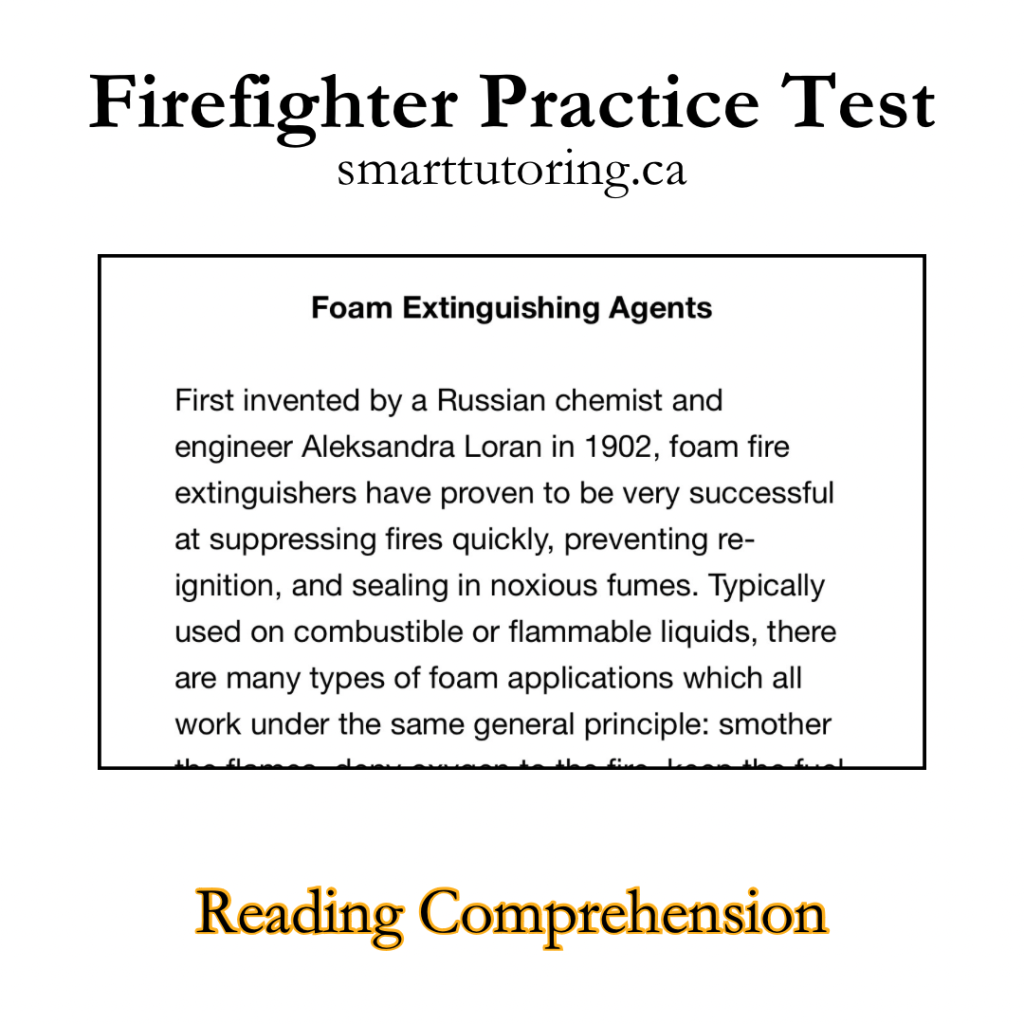
Print this Free Firefighter Aptitude Test!
Firefighter Reading Comprehension
Firefighter reading comprehension test questions are designed to measure a firefighter recruit’s ability to read and understand written communication. This includes information in text, tables, diagrams, charts, and captions.
Firefighter Reading Comprehension Test PDF Directions
In this firefighter reading comprehension practice test, you will read short passages containing fire-related material just as you would in an actual firefighter reading comprehension test.
You will then answer five reading comprehension questions related to the firefighter reading passages.
Use the “Print PDF” feature below to print this free firefighter practice exam.
Use the links to complete a full firefighter practice test for free.
Answers to the firefighter practice test questions are below.
Foam Extinguishing Agents
First invented by a Russian chemist and engineer Aleksandra Loran in 1902, foam fire extinguishers have proven to be very successful at suppressing fires quickly, preventing re-ignition, and sealing in noxious fumes. Typically used on combustible or flammable liquids, there are many types of foam applications which all work under the same general principle: smother the flames, deny oxygen to the fire, keep the fuel source cool and separate from the flame or ignition point, and seal in the fumes generated by the fire.
1. Aleksandra Loran, the Russian chemist, invented the foam extinguisher in __________.
a. 1900
b. 1901
c. 1902
d. 1903
Different foam types possess different expansion rates depending on the need and application. The application rate, measured in gallons per minute per square foot (gpm/ft2) or litres per minute per square metre (lpm/m2), determines how much foam retardant is necessary to successfully extinguish the fire. Dry chemical foam is available in low, medium, or high expansion rates. Application rates directly affect knockdown speed. This measures the speed at which the foam spreads over the surface of the fire, thereby extinguishing it. Obviously, foam only works on flammable liquids that are horizontal in orientation.
2. A foam’s application rate can be measured in litres per minute per square metre or __________.
a. gallons per minute per square foot
b. drain time minus the resistance rate
c. gallons per minute multiplied by the knockdown speed
d. expansion rate minus the drain time multiplied by the application rate
Foam retardants are also measured on their ability to demonstrate heat resistance, that is, the capacity of the foam to withstand heat. Foam is measured for fuel resistance which is its ability to withstand saturation by the fuel, as well as vapour suppression. One of the greatest advantages of foam applications is that they can seal in the deadly vapours generated by the fire and so this becomes a category of investigation, when assessing the success of foam applications. Drain time, the length of time that foam persists after the canister is deployed has been critical to success: the longer the drain time, the better.
3. Foams that possess a long drain time are __________ over foams with short drain times.
a. preferred
b. less effective
c. more volatile
d. weakened by every minute they continue to persist
Two types of foam exist in most applications: FFFP (Film Forming Fluoro-Protein) or AFFF (Aqueous Film Forming Foam). The Fluoro-Protein type of foam is animal-based, sometimes incorporating chicken feathers, oranimal blood in conjunction with metallic salts. While naturally biodegradable,concern revolves around blood-borne pathogens, namely prions, which may escape into the environment during cleanup. Prions are responsible for “mad cow”disease and therefore must be taken seriously. Due to its animal content, FFFP foam often carries an unpleasant smell which makes it less desirable in home or business applications.
4. The Film Forming Fluoro-Protein Foam (FFFP) is ___________ based.
a. blood
b. water
c. animal
d. all of the above
Often preferable, is the AFFF which is water-based, as the acronym suggests. Stored properly, a FFFP extinguisher should last approximately 10 years whereas the AFFF has a considerably longer shelf-life at20-25 years, if only because it contains synthetic materials, rather than natural ones. Currently under investigation through research and development,scientists are testing red palm oil as a new environmentally-sensitive product that carries no smell. While this alternative appears optimistic, tests for its efficacy are still underway.
5. Scientists are researching and developing red palm oil because it
a. carries no smell
b. is an alternative product
c. is environmentally-sensitive
d. all of the above
S.M.A.R.T. Tutoring content is created for Canadian Firefighter Recruits.
© S.M.A.R.T. Tutoring and Test Preparation Services, 2024. All rights reserved. No part of this written content may be reproduced in any form or by any means without the written permission of the copyright owner.
By accessing any of the websites or mailing lists operated by S.M.A.R.T. Tutoring and Test Preparation Services, you, the user, agree to be bound by all of the Terms of Use and agree these terms constitute a binding contract between the user and S.M.A.R.T. Tutoring.
Firefighter Aptitude Test Free PDF Copies:
- Firefighter Oral Comprehension Questions
- Firefighter Reading Ability Questions
- Firefighter Math Questions
- Firefighter Map Reading and Reasoning Questions
- Firefighter Human Relations Questions
Learn. More. Now.
Get Free Firefighter Aptitude Test Questions:
- Join our Firefighter Mailing List and get free firefighter practice test questions!
- Join our Firefighter Mailing List and get free fire recruitment tips!
- Join our Firefighter Mailing List and get free aptitude test preparation tips!
Tap into a NEW way of studying that will SAVE YOU TIME and MONEY!
All you have to do is Join our Firefighter Mailing List!!
ANSWERS:
1. c, 2. a, 3. a, 4. c, 5. d
A score of 4/5 or higher meets standard.
Don’t delay! Start your firefighter test prep today!







